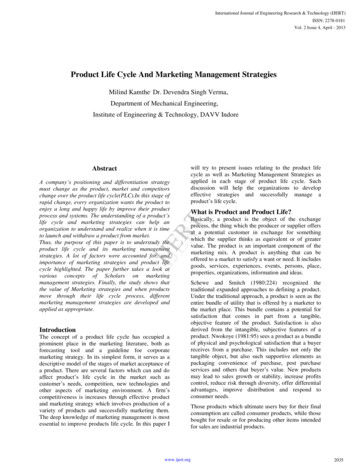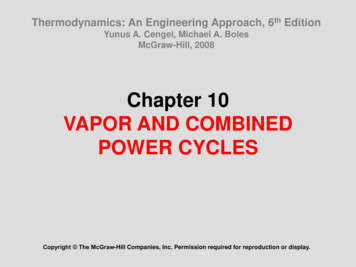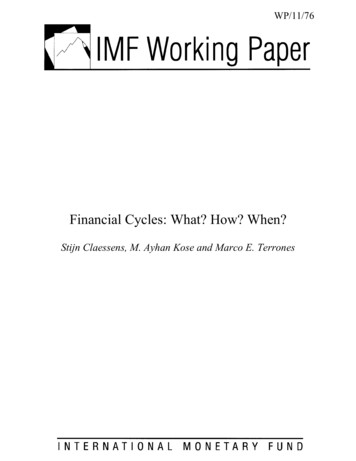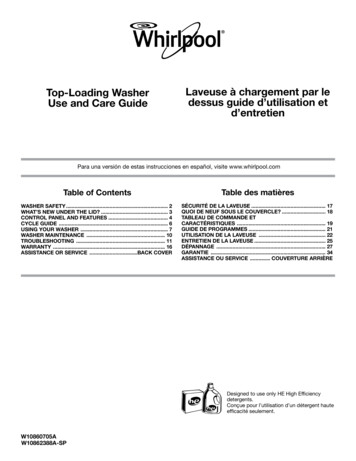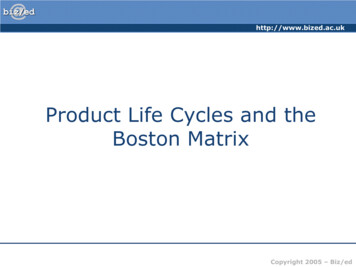
Transcription
http://www.bized.ac.ukProduct Life Cycles and theBoston MatrixCopyright 2005 – Biz/ed
http://www.bized.ac.ukProduct Life Cycles and the BostonMatrix Product Life Cycle – shows the stagesthat products go through fromdevelopment to withdrawal from themarket Product Portfolio – the range ofproducts a company has indevelopment or available for consumersat any one time Managing product portfolio is importantfor cash flowCopyright 2005 – Biz/ed
http://www.bized.ac.ukProduct Life Cycles and the BostonMatrix Product Life Cycle (PLC):––––Each product may have a different life cyclePLC determines revenue earnedContributes to strategic marketing planningMay help the firm to identify when aproduct needs support, redesign,reinvigorating, withdrawal, etc.– May help in new product developmentplanning– May help in forecasting and managing cashflowCopyright 2005 – Biz/ed
http://www.bized.ac.ukProduct Life Cycles and the BostonMatrix The Stages of the Product alCopyright 2005 – Biz/ed
http://www.bized.ac.ukProduct Life Cycles and the BostonMatrix The Development Stage: Initial Ideas – possibly large number May come from any of the following –––––––Market research – identifies gaps in the marketMonitoring competitorsPlanned research and development (R&D)Luck or intuition – stumble across ideas?Creative thinking – inventions, hunches?Futures thinking – what will people beusing/wanting/needing 5,10,20 years hence?Copyright 2005 – Biz/ed
http://www.bized.ac.ukProduct Life Cycles and the BostonMatrix Product Development: Stages– New ideas/possible inventions– Market analysis – is it wanted? Can it beproduced at a profit? Who is it likely to beaimed at?– Product Development and refinement– Test Marketing – possibly local/regional– Analysis of test marketing results andamendment of product/production process– Preparations for launch – publicity,marketing campaignCopyright 2005 – Biz/ed
http://www.bized.ac.ukProduct Life Cycles and the BostonMatrix Introduction/Launch:– Advertising and promotion campaigns– Target campaign at specific audience?– Monitor initial sales– Maximise publicity– High cost/low sales– Length of time – type of productCopyright 2005 – Biz/ed
http://www.bized.ac.ukProduct Life Cycles and the BostonMatrix Growth:– Increased consumer awareness– Sales rise– Revenues increase– Costs - fixed costs/variable costs,profits may be made– Monitor market – competitorsreaction?Copyright 2005 – Biz/ed
http://www.bized.ac.ukProduct Life Cycles and the BostonMatrix Maturity:––––––––Sales reach peakCost of supporting the product declinesRatio of revenue to cost highSales growth likely to be lowMarket share may be highCompetition likely to be greaterPrice elasticity of demand?Monitor market –changes/amendments/new strategies?Copyright 2005 – Biz/ed
http://www.bized.ac.ukProduct Life Cycles and the BostonMatrix Saturation: New entrants likely to mean market is ‘flooded’ Necessity to develop new strategies becomes morepressing:– Searching out new markets:––––– Linking to changing fashions Seeking new or exploiting market segments Linking to joint ventures – media/music, etc.Developing new usesFocus on adapting the productRe-packaging or formatImproving the standard or qualityDeveloping the product rangeCopyright 2005 – Biz/ed
http://www.bized.ac.ukProduct Life Cycles and the BostonMatrix Decline and Withdrawal:– Product outlives/outgrows itsusefulness/value– Fashions change– Technology changes– Sales decline– Cost of supporting starts to rise too far– Decision to withdraw may be dependent onavailability of new products and whetherfashions/trends will come around again?Copyright 2005 – Biz/ed
http://www.bized.ac.ukProduct Life Cycles and the ritySaturationDeclineTimeCopyright 2005 – Biz/ed
http://www.bized.ac.ukProduct Life Cycles and the BostonMatrixSalesEffects of ExtensionStrategiesTimeCopyright 2005 – Biz/ed
http://www.bized.ac.ukProduct Life Cycles and the BostonMatrixSales/ProfitsPLC and ProfitsPLCProfitsTimeLossesBreak EvenCopyright 2005 – Biz/ed
http://www.bized.ac.ukThe Boston Matrix The Boston Matrix:– A means of analysing the product portfolioand informing decision making aboutpossible marketing strategies– Developed by the Boston Consulting Group– a business strategy and marketingconsultancy in 1968– Links growth rate, market share and cashflowCopyright 2005 – Biz/ed
http://www.bized.ac.ukThe Boston Matrix Classifies Products into four simplecategories: Stars – products in marketsexperiencing high growth rateswith a high or increasing share ofthe market- Potential for high revenue growthCopyright 2005 – Biz/ed
http://www.bized.ac.ukThe Boston Matrix Cash Cows:– High market share– Low growthmarkets –maturity stage ofPLC– Low cost support– High cash revenue– positive cashflowsCopyright 2005 – Biz/ed
http://www.bized.ac.ukThe Boston Matrix Dogs:– Products in a lowgrowth market– Have low or decliningmarket share (declinestage of PLC)– Associated withnegative cash flow– May require largesums of money tosupportIs your product starting toembarrass your company?Copyright 2005 – Biz/ed
http://www.bized.ac.ukThe Boston Matrix Problem Child:- Products having alow market share ina high growthmarket- Need money spentto develop them- May producenegative cash flow- Potential for thefuture?Problem children – worth spendinggood money on?Copyright 2005 – Biz/ed
http://www.bized.ac.ukThe Boston MatrixMarket GrowthHigh Problem ChildrenDogsLowStarsCash CowsMarket ShareHighCopyright 2005 – Biz/ed
http://www.bized.ac.ukThe Boston Matrix Implications: Dogs:––––Are they worth persevering with?How much are they costing?Could they be revived in some way?How much would it cost to continue tosupport such products?– How much would it cost to remove from themarket?Copyright 2005 – Biz/ed
http://www.bized.ac.ukThe Boston Matrix Implications: Problem Children:– What are the chances of theseproducts securing a hold in themarket?– How much will it cost to promotethem to a stronger position?– Is it worth it?Copyright 2005 – Biz/ed
http://www.bized.ac.ukThe Boston Matrix Implications: Stars:– Huge potential– May have been expensive to develop– Worth spending money to promote– Consider the extent of their productlife cycle in decision makingCopyright 2005 – Biz/ed
http://www.bized.ac.ukThe Boston Matrix Implications: Cash Cows:– Cheap to promote– Generate large amounts of cash – use forfurther R&D?– Costs of developing and promoting havelargely gone– Need to monitor their performance – thelong term?– At the maturity stage of the PLC?Copyright 2005 – Biz/ed
http://www.bized.ac.ukSalesThe Product Life Cycle and theBoston Matrix Importance of(1)(2)(3)Cashfrom(2)Cashfrom‘B’maintaininga balanceofproductsusedtosupportstage to– cashcow.portfolio–fourgrowthof rentstagesofofthe developmentstageandportfoliothePLC ‘D’.– Bostonextensionstrategy‘D’launch‘A’ nowMatrixwith thefor‘B’?helpspossiblya dog?(3)analysisDABCTimeCopyright 2005 – Biz/ed
http://www.bized.ac.ukBostonská matice – zdroj :http://www.dpu.se/boston e.htmlCopyright 2005 – Biz/ed
http://www.bized.ac.ukJak je to ve skutečnostiCopyright 2005 – Biz/ed
Product Life Cycles and the Boston Matrix Product Life Cycle (PLC): -Each product may have a different life cycle -PLC determines revenue earned -Contributes to strategic marketing planning -May help the firm to identify when a product needs support, redesign, reinvigorating, withdrawal, etc. -May help in new product development .





